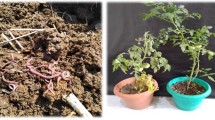Summary
Several fungicides were compared for control of late blight of potatoes at Hastings, Florida, during a six-year period. Percentage foliage killed by late blight, weight of tubers produced and percentage of those affected with the disease in the treated and nontreated plots were used in evaluating the fungicides.
In 1949 when the disease killed all non-treated plants 79 days from planting. Dithane D14-ZnSO4 and Parzate liquid-ZnSO4 sprays gave about the same degree of control. They were slightly more effective than tribasic copper-zinc spray and much more effective in preventing foliage and tuber infection than zineb, tribasic copper-zinc and copper compound A dusts. The treated potatoes outyielded the non-treated 64 to 85 hundred pound sacks per acre, but differences in yields of potatoes treated with the different fungicides were not significant.
All fungicides tested in 1952 and 1953 when blight was mild and moderately severe gave good control of the disease.
Plants treated with copper compound A dust yielded 20 to 25 sacks per acre less than nontreated plants and those sprayed with maneb and captan in 1951 when late blight was not present.
When the disease was moderately severe in 1953, the maneb-sprayed plants out-yielded those sprayed with nabam-ZnSCO4, captan and ethylene bisthiuram disulfide by 30 to 36 sacks per acre. Plants sprayed with copper compound A also yielded 30 to 32 sacks per acre more than those treated with nabam-ZnSCO4 and ethylene bisthiuram trisulfide.
Similar content being viewed by others
Literature Cited
Cook, Harold T. 1949. Forecasting late blight epiphytotics of potatoes and tomatoes. Jour. Agr. Res. 78: 545–563.
Crosier, Willard. 1934. Studies in the biology ofPhytophthora infestans (Mont.) De Bary. N. Y. (Cornell) Agr. Exp. Sta. Mem. 155.
Eddins, A. H. 1945. Transmission and spread of late blight in seed potatoes. Amer. Potato Jour. 22: 333–339.
— and C. N. Clayton. 1943. Late blight of potatoes and its control under southern conditions. Amer. Potato Jour. 20: 107–112.
Gratz, L. O. 1930. Potato spraying and dusting experiments in Florida, 1924 to 1929. Fla. Agr. Exp. Sta. Bull. 222.
Hyre, R. A. 1954. Progress in forecasting late blight of potato and tomato. Plant Dis. Rept. 38: 245–253.
— and Reiner Bonde. 1955. Forecasting late blight of potato in Northern Maine. Amer. Potato Jour. 32: 119–125.
Ruehie, Geo. D. 1944. A new organic fungicide for control of potato late blight in Florida. Fla. Agr. Exp. Sta. Press Bull. 598.
—. 1947. Recent spray tests for control of potato late blight in subtropical Florida. Amer. Potato Jour. 24: 299–307.
-. Control of potato diseases in Dade County. Fla. Agr. Exp. Sta. Ann. Repts. 1948, 253–255; 1949, 249–253; 1950, 235; 1951, 251; 1952, 279; and 1953, 318–319.
Author information
Authors and Affiliations
Additional information
Florida Agricultural Experiment Station Journal Series No. 533.
Rights and permissions
About this article
Cite this article
Eddins, A.H. Control of late blight of potatoes with fungicides at Hastings, Florida. American Potato Journal 34, 42–48 (1957). https://doi.org/10.1007/BF02855009
Accepted:
Issue Date:
DOI: https://doi.org/10.1007/BF02855009




